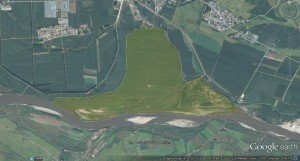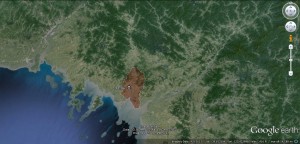This article contains a wealth on information on Chinese investment and financial support of the DPRK.
On his ninth business trip to North Korea this year, Hao Ze has been meeting government officials to finalise his latest investment deal, providing equipment to mine rutile, an ingredient in paints, plastics and sunscreen.
The work at the mineral ore deposit will add to Hao’s growing business empire, which includes a plant manufacturing car parts, a restaurant and a spa – all investments in a country run by a reclusive dictatorship.
Hao is among a growing league of private Chinese investors lured by North Korea’s powerful business potential and undeterred by its unpredictable politics. The investments are fuelling growth in North Korea’s economy, as well as concerns among Western analysts that the boom could encourage more erratic behaviour by the hermit kingdom.
There, Chinese investors dominate certain business sectors – in particular, mining – and its one reason many analysts say that North Korea’s feeble economy appears to be improving.
Before 2011, North Korea had been running a deficit. Two prominent economists have estimated that the country enjoyed a small surplus over the last two years. Last year, the country’s gross domestic product grew by 1.3 per cent, according to Bank of South Korea. The bank did not provide any dollar figures.
Most of these business deals are private and sealed outside of the Chinese government’s control. The exact size of the investments could not be gleaned. But many of the arrangements are profitable and have inadvertently increased Pyongyang’s dependence on its closest ally, Beijing, even as China has shown apparent frustration with the nuclear ambitions of supreme leader Kim Jong-un.
The increase in North Korea’s wealth from the investments could also shift the country’s engagement, or lack of it, with the outside world. Some researchers fear that with more capital, North Korea’s nuclear ambitions might grow bolder. The country will also have less incentive to introduce economic changes. Other researchers express hope that foreign investment creates an opportunity for more fruitful engagement with the outside world and the international community.
Raised in the central province of Zhejiang , Hao’s interest in North Korea was piqued by his grandfather, who fought in the Korean war in the 1950s. The grandson started travelling to North Korea in 2004 with friends to distribute food and money. He cultivated contacts and resourceful middlemen, and relied on those people when, in 2010, he started to import North Korean ginseng and honey to China. His portfolio expanded steadily and now includes a variety of small businesses on the peninsula.
He and several Chinese partners have invested 10 million yuan (HK$12.6 million) in Pyongyang, where he employs about 150 local workers, built an 8,000-square-metre factory compound and runs a restaurant and spa.
“There certainly are risks,” Hao says. “But this place is just like China in the 1980s. It’s highly risky, but it’s also highly profitable if you seize the opportunity.”
The actual size of private Chinese investment in North Korea is hard to gauge. Chinese citizens had poured about US$6 billion into businesses in North Korea by 2011, according to Sheila Miyoshi Jager, an associate professor of East Asian studies at Oberlin College in the United States.
China’s non-financial foreign direct investment in North Korea had reached US$290 million by the end of 2010, according to China’s Ministry of Commerce, a figure included in a report last year by the newspaper Oriental Morning Post in Shanghai. Hao and other academics say the figure is growing as more Chinese investors with an appetite for risk venture into North Korea.
And risks there are. Last year, a rare open row between a Chinese company and the North Korean government drew international attention to Korea’s opaque rules and arbitrary decisions. Chinese fertiliser and mineral producer Xiyang Group said in an August 2012 blog post that, after it had spent four years and 240 million yuan on an iron ore enterprise, North Korean authorities suddenly cancelled the company’s contract last year. The company said it was cheated out of its mining assets after North Korean officials extorted more than US$800,000 from the Chinese firm.
Xiyang called its venture a “nightmare” and said estimates of their losses were US$55.3 million. North Korean state media denied the claims and said the company implemented just 50 per cent of its investment obligations. Beijing has stayed silent about the dispute.
The incident has not dampened the enthusiasm of Chinese investors. Hao says that private businessmen like him are lured by a large pool of cheap labour and lower operating costs. Despite an unstable electrical power supply, utility fees and taxes are much lower than in China.
Almost 90 per cent of the more than 300 Chinese investors surveyed in 2007 reported making a profit in North Korea despite problems such as asset theft and rampant corruption, according to a survey by Marcus Noland and Stephan Haggard, two economists at the Peterson Institute for International Economics in Washington.
“That’s partly because this place is so isolated and so underdeveloped that if you can avoid major problems, there is money to be made,” Noland says.
Hao made big profits in the manufacturing and service industries. Now he’s setting his sights on North Korea’s mining sector, an increasingly important component of the country’s economy that has otherwise been severed from international trade.
That’s partly because of sanctions imposed by the United Nations and Western countries. Hao intends to invest 36 million yuan in his rutile venture, working with a company from Qinghai , which Hao declines to name as the deal is not finalised.
Chinese investors dominate North Korea’s mining industry. According to the US Korea Institute at John Hopkins University in the US, 41 per cent of the 138 Chinese companies registered as doing business in North Korea in 2010 were involved in the mining industry.
However, Zhang Huizhi from Jilin University’s North East Research Centre says that many private Chinese investors are working in North Korea without registering with Chinese authorities.
It’s believed that North Korea has around 200 different minerals and US$6 trillion worth of rare elements and mineral deposits including magnetite, zinc, copper and limestone, according to estimates by the South Korean state-owned mining company Korea Resources.
However, many international investors are turned off by North Korea’s cryptic business environment, unstable politics and faulty infrastructure, which have made operating mines and transporting minerals difficult. Chinese businessmen, though, plough ahead thanks to their proximity, access to savvy Chinese middlemen who speak Korean and connections on both sides of the border. “These are the resources not available for other investors,” says Scott Bruce, an associate with the East West Centre in the United States.
Coal mining is a popular choice for Chinese businesses. According to Bruce, many Chinese investors pay far less for North Korean coal than for what’s extracted from other countries. North Korea, however, pays a premium for Chinese coal imports.
“The Chinese investors have to deal with huge risks to get in and out of the country. They often have to build infrastructure to access the minerals, so they are looking for their costs to reflect those risks,” Bruce says.
Since he inherited power in 2011, supreme leader Kim has pledged to revive the country’s economy. In October, Pyongyang announced a plan to establish 14 special economic zones to attract more foreign investment. Last year, the government began allowing North Koreans to work in China. But experts wonder whether Kim is committed to opening economic borders or if he will roll back the few existing reforms, as his father did, for fear of losing authority.
Recent visitors to North Korea do not dispute that the country’s economy may be improving.
“There are a lot more taxis on the road. More people are using cell phones. And you would be surprised to see that the restaurants are actually packed,” says Wu Wenxing, a Chinese businessman who has visited the country five times since last year.
No hard figures are available to indicate the country’s economic performance. But according to ongoing research by Noland and Haggard, the country is likely to have run a surplus in the past two years largely because of growing trade with China.
While analysts are still trying to explain the sudden growth in wealth, many see China’s economic presence, especially in the mining industry, as a major contributing factor. Despite Beijing’s support for the latest round of United Nations sanctions against North Korea, bilateral trade between the two nations hit a record high in the first eight months of this year.
Noland said a wealthier North Korea could mean that the country would be less vulnerable to international pressure.
Remco Breuker from Leiden University in the Netherlands agrees. He says that the international community could be forced to readjust how it engages with North Korea. More international investments, he argues, could prod the country to become a better international neighbour.
“For years it has been the premise of US policy towards the North that if you exert enough pressure, the country will collapse. But it’s not happening, and in fact the country is in the black,” Breuker says. “We have to realise North Korea is here to stay.”
North Korea’s parallel development of nuclear weapons would hamper its economic development, Noland says. Most of the nuclear and missile tests would be followed by UN sanctions, a key detractor for international investors.
Expanding the country’s mineral extraction might have an economic downside. Bruce from the East West Centre says it may convince North Korea that it’s better to sell its resources for short-term cash while delaying productive economic changes that would promote long-term growth.
Sunny Lee, a fellow with the Shorenstein Asia-Pacific Research Centre at Stanford University, says that Beijing would not mind a wealthier North Korea as long as it maintains a good relationship with Beijing.
“Given the economic sanctions from the US and its allies, Pyongyang’s economic dependence on China is bound to deepen,” Lee says.
For businessmen like Hao, all is well as long as business is good. “We are expecting to recoup all our investment next year,” he says.


